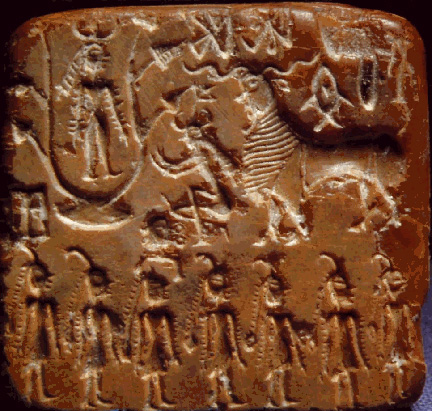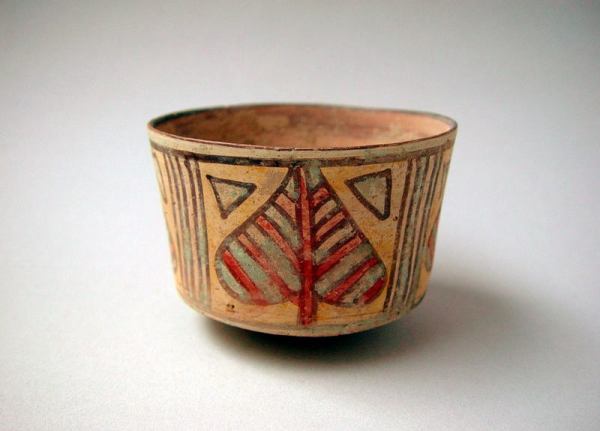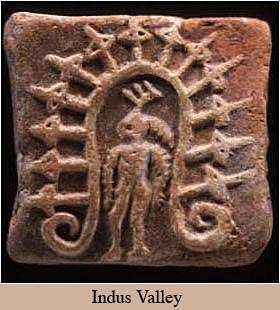சிந்து சமவெளியில் அரசமரம்

வ்ருக்ஷ ராஜன்
சிந்து சமவெளியில் பல விநோதமான விஷயங்களைப் பார்க்க முடிகிறது. புலிப் பெண் முத்திரை, பேய் முத்திரை, ஆடு, நரபலி முத்திரை, சப்தமாதா முத்திரை, மிருகங்கள் சூழ்ந்து நிற்கும் (பசுபதி) ஒரு கடவுள் முத்திரை, யானை மீது இந்திரன் போல நிற்கும் ஒருவர்/ஒருத்தி முத்திரை , ஆட்டுமுக அசுரன் அல்லது தேவன் முத்திரை, மஹிஷாசுரமர்த்தனி போல எருமையை துவம்சம் செய்யும் ஆண் முத்திரை எனப் பல முத்திரைகள்.
இவைகளில் பல முத்திரைகளுக்கு ஒரே நூலிலிருந்து விளக்கம் சொல்ல முடியவில்லை. ஆனால் பல சம்ஸ்கிருத நூல்களில் இருந்து விளக்கம் சொல்ல முடிகிறது. யாருக்கும் புரியாத மர்மமான ஒட்டக எலும்புக்கூடு, ஒட்டக முத்திரை ஆகியனவும் கிடைத்தன. இந்த ஒட்டக விஷயம் ஆரிய-திராவிட வாதத்துக்கு எதிராக இருப்பதால் அறிஞர்கள் ஒரே அமுக்காக அமுக்கிவிட்டனர். எந்த அறிஞரும் அது பற்றி பிரஸ்தாபிப்பதே இல்லை.
இதே போல எலும்புக்கூடு விஷயங்களையும் அமுக்கிவிட்டனர். ஏனெனில் இதில் ஆரிய திராவிட எலும்புக் கூடுகள் என்று இனம் காட்ட முடியவில்லை. அப்படியே காட்டப் போனால் எல்லாம் பஞ்சாபியர் எலும்புக் கூடுகள் போலவே தோற்றம் இருக்கின்றன!!!
சிந்துவெளி முத்திரையில் பலவிதமான மரங்கள் காணப்பட்டாலும் அரமரம் கொஞ்சம் தூக்கலாகத் தெரிகிறது. இதைப் பார்த்தவுடன் பலருக்கு ஒரே மகிழ்ச்சி. அப்பாடா, திராவிடப் பொன்னாட்டை தொடர்புபடுத்த ஒரு விஷயமாவது கிடைத்ததே என்று. உண்மையில் இதுவும் பிழை. தன்னை ஆரியன் என்று அழைத்துக் கொண்ட புத்த பிரான உட்கார்ந்து ஞானோதயம் பெற்றது அரச மரத்துக்கடியில் தான். அவர் ஏன் அரச மரத்துக்கு அடியில் உட்கார்ந்தார் என்றால் அந்த மரம் வேத காலத்தில் இருந்து புனிதமாக கருதப்பட்டது. பிராமணர்கள் அரச மரக் குச்சிகள் இல்லாமல் தங்கள் யாக யக்ஞங்களைச் செய்ய முடியாது.
மூலதோ ப்ரஹ்மரூபாய மத்யதோ விஷ்ணு ரூபிணே
அக்ரதச் சிவ ரூபாய வ்ருக்ஷ ராஜாய தே நம:
பொருள்: அடியில் பிரம்மனும் நடுவில் விஷ்ணுவும், நுனியில் சிவ பெருமானும், நிலைபெற்ற அரச மரமே உனக்கு நமஸ்காரம். இது ஒரு பழைய ஸ்லோகம். இந்துக்கள் வழிபடும் மரம்--அரச மரம்.

அரச மரம் மட்டுமின்றி அந்தக் குடும்பத்தைச் சேர்ந்த அத்தி, ஆலம் ஆகியனவும் இந்துக்கள் வழிபாட்டில் இடம் பெற்றன. தாவரவியல் கணக்குப்படி மூன்றும் ‘பைகஸ்’ என்னும் பிரிவைச் சேர்ந்தவை, ஒரே குடும்பத்தைச் சேர்ந்தவை. (இந்திய அதிசயம் ஆலமரம் என்ற எனது கட்டுரையில் மேல் விவரம் காண்க)
அரச மரத்தைக் குறிக்கும் பிப்பலாடன், அச்வத்தன் என்ற மனிதர்களுடைய பெயர்கள் இதிஹாச உபநிஷத்திலும் இருக்கின்றன.
விஷ்ணு சஹஸ்ரநாமம்
விஷ்ணு சஹஸ்ரநாமம் மிகவும் பழமையான ஒரு ஸ்லோகம். அது மஹா பரதத்தில் இருக்கிறது. அதில் பல வேதகாலப் பெயர்கள் இருக்கின்றன. அதில் மூன்று மரங்களின் பெயர்களும் விஷ்ணுவின் பெயர்களாக வருகின்றன. அதற்கு ஆதி சங்கரர் எழுதிய விளக்கங்களையும் கீழே காணலாம்.
822.ந்யக்ரோதாய
823.உதும்பராய
824.அஸ்வத்தாய
822.கீழேயுள்ள பிரபஞ்சத்துக்கெல்லாம் மேலாயிருப்பவர் அல்லது தமது மாயையினால் எல்லாப் பிராணிகளையும் கீழே வைத்து மறைப்பவர்
823.ஆகாயத்திற்கு மேற்பட்டவர்
824.அரசமரம் போலிருப்பவர்.
கீதையில் அரசமரம்
புத்தருக்கெல்லாம் மிகவும் முந்தியவர் கிருஷ்ண பரமாத்மா. அவர் சொன்ன பகவத் கீதையில் மரங்களில் தான் அரச மரம் என்றே கூறுகிறார்.
‘’எல்லா மரங்களுள்ளும் நான் அரச மரமாயிருக்கிறேன்’’ (கீதை 10-26)
ஊர்த்வ மூலமத: ஸாகமஸ்வத்தம் ப்ராஹுரவ்யயம் (கீதை 15.1) என்ற இடத்திலும் அரச, ஆல மரங்களின் பெருமை பேசப்படுகிறது.
பிராமணர்கள் தினசரி சமிதாதானத்திலும் ஹோமத்திலும் பயன்படுத்துவது அரச மரக்குச்சிகளே. அர மரக் குச்சிகள் (ஸமித்து) இல்லாமல் அவர்கள் அடிப்படை ஹோமங்களைக் கூட செய்ய முடியாது. அவ்வளவு முக்கியம். புத்தர் அரச (போதி) மரத்துக்கடியில் உட்கார்ந்ததற்கும் இதுவே காரணம்.
இவ்வளவு புகழ் பெற்ற அரசமரத்துக்கும் திராவிட முத்திரை குத்தி சில அரை வேக்காடுகள் மகிழ்கின்றன.மகிழட்டுமே, நமக்கென்ன நஷ்டம்!

அரச மரமும் பிள்ளைப்பேறும்
பிள்ளை பெற தயாராக இருப்பவர்களும் மகப்பேறு கிடைக்காதவர்களும் அரசமரத்தைச் சுற்றினால் குழந்தை பிறக்கும் என்பது தமிழர்களின் நம்பிக்கை. இதனால்தான் பிள்ளையார் சிலைகளை அரச மரத்துக்கு அடியில் வைத்தனர்.
‘’அரச மரத்தைச் சுற்றிவிட்டு அடிவயிற்றில் கை வைத்தாளாம்’’-- என்ற பழமொழியும் இதனால்தான் வந்தது. உடனே பிள்ளை பிறந்துவிடும் என்ற நம்பிக்கை!
வேதத்தில் அரசமரம்
அரச மரம், ஆலமரம் ஆகியவை பற்றிய குறிப்புகள் வேதத்திலும் சங்க இலக்கியத்திலும் வருகின்றன. உலகிலேயே பழமையான சமய நூல் ரிக் வேதம். அதில் பத்தாவது மண்டலத்தில் பலன் தரும் மூலிகைகள் என்ற பாடலில் (10-97) அரச மரம் பற்றி வருகிறது : ‘’உனது வீடு புனிதமான அரச மரத்தில் உள்ளது. இலைகளுடைய பர்னா (பலாச) மரத்தில் உன் வீடு கட்டப்பட்டுள்ளது. இந்த மனிதனைக் காப்பாற்றினால் உனக்கு ஒரு பசு கிடைக்கும்’’.
யாகத்தில் பயன்படுத்தப்படும் பாத்திரங்கள், கரண்டிகள் ஆகியன இந்த 2 மரங்களினால் செய்யப்படுகின்றன.
ஐயவி புகைத்தல்
பேயை விரட்ட ஐயவி என்னும் வெண் கடுகின் புகையை சாம்பிராணி புகை போல போடுவது சங்க கால வழக்கம். இதுவும் வடக்கிலும் இருப்பதை ஒரு சம்ஸ்கிருத நூல் கூறுகிறது. அமோகவஜ்ரர் என்பவர் எழுதிய வடமொழி நூலில் இது துர்தேவதைகளை விரட்டப் பயன்படும் என்று எழுதப்படிருக்கிறது. ஐயவி பற்றிய குறிப்புகள் சங்க இலக்கியத்தில் பல இடங்களில் வருகிறது (எனத் ‘’தமிழில் பேய், பூத, பிசாசு’’ என்ற கட்டுரையில் விவரங்கள் கிடைக்கும்.
Please read my earlier articles:
1.Serpent Queen: From Indus Valley to Sabarimalai 2.Sugarcane Mystery: Indus valley and Ikshvaku Dynasty 3. Vishnu seal In Indus Valley 4. Indus Valley –New Approach required 5.Indra in Indus valley seals+ Symbols for Vedic Gods and 6.Ghost in Indus seals 7. Bull Fighting: From Indus Valley to Spain via Tamil Nadu 8.The Great Scorpion Mystery in History 9. (In Tamil) சிந்து சமவெளியில் புலிப்பெண் 10. சிந்து சமவெளியில் பேய் முத்திரை 11. Ramayana Wonders part 5: Indus Valley Cities in Ramayana 12.Tiger Goddess in Indus seals 13.Aryan Chapatti and Dravidian Dosa 14.Sex Worship in Indus Valley 15.சிந்து சமவெளியில் செக்ஸ் வழிபாடு 16.Indian Wonder: The Banyan Tree + 600 articles on Tamil Sanskrit Literature and Indian Culture.

வ்ருக்ஷ ராஜன்
சிந்து சமவெளியில் பல விநோதமான விஷயங்களைப் பார்க்க முடிகிறது. புலிப் பெண் முத்திரை, பேய் முத்திரை, ஆடு, நரபலி முத்திரை, சப்தமாதா முத்திரை, மிருகங்கள் சூழ்ந்து நிற்கும் (பசுபதி) ஒரு கடவுள் முத்திரை, யானை மீது இந்திரன் போல நிற்கும் ஒருவர்/ஒருத்தி முத்திரை , ஆட்டுமுக அசுரன் அல்லது தேவன் முத்திரை, மஹிஷாசுரமர்த்தனி போல எருமையை துவம்சம் செய்யும் ஆண் முத்திரை எனப் பல முத்திரைகள்.
இவைகளில் பல முத்திரைகளுக்கு ஒரே நூலிலிருந்து விளக்கம் சொல்ல முடியவில்லை. ஆனால் பல சம்ஸ்கிருத நூல்களில் இருந்து விளக்கம் சொல்ல முடிகிறது. யாருக்கும் புரியாத மர்மமான ஒட்டக எலும்புக்கூடு, ஒட்டக முத்திரை ஆகியனவும் கிடைத்தன. இந்த ஒட்டக விஷயம் ஆரிய-திராவிட வாதத்துக்கு எதிராக இருப்பதால் அறிஞர்கள் ஒரே அமுக்காக அமுக்கிவிட்டனர். எந்த அறிஞரும் அது பற்றி பிரஸ்தாபிப்பதே இல்லை.
இதே போல எலும்புக்கூடு விஷயங்களையும் அமுக்கிவிட்டனர். ஏனெனில் இதில் ஆரிய திராவிட எலும்புக் கூடுகள் என்று இனம் காட்ட முடியவில்லை. அப்படியே காட்டப் போனால் எல்லாம் பஞ்சாபியர் எலும்புக் கூடுகள் போலவே தோற்றம் இருக்கின்றன!!!
சிந்துவெளி முத்திரையில் பலவிதமான மரங்கள் காணப்பட்டாலும் அரமரம் கொஞ்சம் தூக்கலாகத் தெரிகிறது. இதைப் பார்த்தவுடன் பலருக்கு ஒரே மகிழ்ச்சி. அப்பாடா, திராவிடப் பொன்னாட்டை தொடர்புபடுத்த ஒரு விஷயமாவது கிடைத்ததே என்று. உண்மையில் இதுவும் பிழை. தன்னை ஆரியன் என்று அழைத்துக் கொண்ட புத்த பிரான உட்கார்ந்து ஞானோதயம் பெற்றது அரச மரத்துக்கடியில் தான். அவர் ஏன் அரச மரத்துக்கு அடியில் உட்கார்ந்தார் என்றால் அந்த மரம் வேத காலத்தில் இருந்து புனிதமாக கருதப்பட்டது. பிராமணர்கள் அரச மரக் குச்சிகள் இல்லாமல் தங்கள் யாக யக்ஞங்களைச் செய்ய முடியாது.
மூலதோ ப்ரஹ்மரூபாய மத்யதோ விஷ்ணு ரூபிணே
அக்ரதச் சிவ ரூபாய வ்ருக்ஷ ராஜாய தே நம:
பொருள்: அடியில் பிரம்மனும் நடுவில் விஷ்ணுவும், நுனியில் சிவ பெருமானும், நிலைபெற்ற அரச மரமே உனக்கு நமஸ்காரம். இது ஒரு பழைய ஸ்லோகம். இந்துக்கள் வழிபடும் மரம்--அரச மரம்.

அரச மரம் மட்டுமின்றி அந்தக் குடும்பத்தைச் சேர்ந்த அத்தி, ஆலம் ஆகியனவும் இந்துக்கள் வழிபாட்டில் இடம் பெற்றன. தாவரவியல் கணக்குப்படி மூன்றும் ‘பைகஸ்’ என்னும் பிரிவைச் சேர்ந்தவை, ஒரே குடும்பத்தைச் சேர்ந்தவை. (இந்திய அதிசயம் ஆலமரம் என்ற எனது கட்டுரையில் மேல் விவரம் காண்க)
அரச மரத்தைக் குறிக்கும் பிப்பலாடன், அச்வத்தன் என்ற மனிதர்களுடைய பெயர்கள் இதிஹாச உபநிஷத்திலும் இருக்கின்றன.
விஷ்ணு சஹஸ்ரநாமம்
விஷ்ணு சஹஸ்ரநாமம் மிகவும் பழமையான ஒரு ஸ்லோகம். அது மஹா பரதத்தில் இருக்கிறது. அதில் பல வேதகாலப் பெயர்கள் இருக்கின்றன. அதில் மூன்று மரங்களின் பெயர்களும் விஷ்ணுவின் பெயர்களாக வருகின்றன. அதற்கு ஆதி சங்கரர் எழுதிய விளக்கங்களையும் கீழே காணலாம்.
822.ந்யக்ரோதாய
823.உதும்பராய
824.அஸ்வத்தாய
822.கீழேயுள்ள பிரபஞ்சத்துக்கெல்லாம் மேலாயிருப்பவர் அல்லது தமது மாயையினால் எல்லாப் பிராணிகளையும் கீழே வைத்து மறைப்பவர்
823.ஆகாயத்திற்கு மேற்பட்டவர்
824.அரசமரம் போலிருப்பவர்.
கீதையில் அரசமரம்
புத்தருக்கெல்லாம் மிகவும் முந்தியவர் கிருஷ்ண பரமாத்மா. அவர் சொன்ன பகவத் கீதையில் மரங்களில் தான் அரச மரம் என்றே கூறுகிறார்.
‘’எல்லா மரங்களுள்ளும் நான் அரச மரமாயிருக்கிறேன்’’ (கீதை 10-26)
ஊர்த்வ மூலமத: ஸாகமஸ்வத்தம் ப்ராஹுரவ்யயம் (கீதை 15.1) என்ற இடத்திலும் அரச, ஆல மரங்களின் பெருமை பேசப்படுகிறது.
பிராமணர்கள் தினசரி சமிதாதானத்திலும் ஹோமத்திலும் பயன்படுத்துவது அரச மரக்குச்சிகளே. அர மரக் குச்சிகள் (ஸமித்து) இல்லாமல் அவர்கள் அடிப்படை ஹோமங்களைக் கூட செய்ய முடியாது. அவ்வளவு முக்கியம். புத்தர் அரச (போதி) மரத்துக்கடியில் உட்கார்ந்ததற்கும் இதுவே காரணம்.
இவ்வளவு புகழ் பெற்ற அரசமரத்துக்கும் திராவிட முத்திரை குத்தி சில அரை வேக்காடுகள் மகிழ்கின்றன.மகிழட்டுமே, நமக்கென்ன நஷ்டம்!

அரச மரமும் பிள்ளைப்பேறும்
பிள்ளை பெற தயாராக இருப்பவர்களும் மகப்பேறு கிடைக்காதவர்களும் அரசமரத்தைச் சுற்றினால் குழந்தை பிறக்கும் என்பது தமிழர்களின் நம்பிக்கை. இதனால்தான் பிள்ளையார் சிலைகளை அரச மரத்துக்கு அடியில் வைத்தனர்.
‘’அரச மரத்தைச் சுற்றிவிட்டு அடிவயிற்றில் கை வைத்தாளாம்’’-- என்ற பழமொழியும் இதனால்தான் வந்தது. உடனே பிள்ளை பிறந்துவிடும் என்ற நம்பிக்கை!
வேதத்தில் அரசமரம்
அரச மரம், ஆலமரம் ஆகியவை பற்றிய குறிப்புகள் வேதத்திலும் சங்க இலக்கியத்திலும் வருகின்றன. உலகிலேயே பழமையான சமய நூல் ரிக் வேதம். அதில் பத்தாவது மண்டலத்தில் பலன் தரும் மூலிகைகள் என்ற பாடலில் (10-97) அரச மரம் பற்றி வருகிறது : ‘’உனது வீடு புனிதமான அரச மரத்தில் உள்ளது. இலைகளுடைய பர்னா (பலாச) மரத்தில் உன் வீடு கட்டப்பட்டுள்ளது. இந்த மனிதனைக் காப்பாற்றினால் உனக்கு ஒரு பசு கிடைக்கும்’’.
யாகத்தில் பயன்படுத்தப்படும் பாத்திரங்கள், கரண்டிகள் ஆகியன இந்த 2 மரங்களினால் செய்யப்படுகின்றன.
ஐயவி புகைத்தல்
பேயை விரட்ட ஐயவி என்னும் வெண் கடுகின் புகையை சாம்பிராணி புகை போல போடுவது சங்க கால வழக்கம். இதுவும் வடக்கிலும் இருப்பதை ஒரு சம்ஸ்கிருத நூல் கூறுகிறது. அமோகவஜ்ரர் என்பவர் எழுதிய வடமொழி நூலில் இது துர்தேவதைகளை விரட்டப் பயன்படும் என்று எழுதப்படிருக்கிறது. ஐயவி பற்றிய குறிப்புகள் சங்க இலக்கியத்தில் பல இடங்களில் வருகிறது (எனத் ‘’தமிழில் பேய், பூத, பிசாசு’’ என்ற கட்டுரையில் விவரங்கள் கிடைக்கும்.
Please read my earlier articles:
1.Serpent Queen: From Indus Valley to Sabarimalai 2.Sugarcane Mystery: Indus valley and Ikshvaku Dynasty 3. Vishnu seal In Indus Valley 4. Indus Valley –New Approach required 5.Indra in Indus valley seals+ Symbols for Vedic Gods and 6.Ghost in Indus seals 7. Bull Fighting: From Indus Valley to Spain via Tamil Nadu 8.The Great Scorpion Mystery in History 9. (In Tamil) சிந்து சமவெளியில் புலிப்பெண் 10. சிந்து சமவெளியில் பேய் முத்திரை 11. Ramayana Wonders part 5: Indus Valley Cities in Ramayana 12.Tiger Goddess in Indus seals 13.Aryan Chapatti and Dravidian Dosa 14.Sex Worship in Indus Valley 15.சிந்து சமவெளியில் செக்ஸ் வழிபாடு 16.Indian Wonder: The Banyan Tree + 600 articles on Tamil Sanskrit Literature and Indian Culture.

